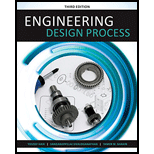
Use the statement “Connect two bodies of water with no gradient.” Develop a series of questions to better understand the need.
The series of questions to better understand the need using the statement, “Connect two bodies of water with no gradient”.
Explanation of Solution
A need is an indefinite wishes that expresses what the customers would like a product to do for them whereas the requirements are the designer’s detailed breakdown of what the product should do and achieved based on the customers’ statements.
Why to connect two bodies of water with no gradient?
What material should be used to connect two bodies of water with no gradient?
From where to connect two bodies of water with no gradient?
When to connect two bodies of water with no gradient?
How to connect two bodies of water with no gradient?
Thus, the above are the series of questions to better understand the need using the statement, “Connect two bodies of water with no gradient”.
Want to see more full solutions like this?
Chapter 5 Solutions
ENGINEERING DESIGN PROCESS
- Identify how the hydro resource of a river can be described.arrow_forwardShow Complete Solutionarrow_forwardThe initial cost of a pickup truck is $10,048 and will have a salvage value of $4,400 after five years. Maintenance is estimated to be a uniform gradient amount of $132 per year, with zero dollar for first year maintenance. The operation cost is estimated to be $0.26 per mile for 280 miles per month. If the interest rate is 12%, what is the annual equivalent cost (AEC) for the truck? Enter your answer as follow: 123456arrow_forward
- HYDRAULICS Support your answer with the appropriate solution and diagram. 8.A stone weighs 490.5 N in air and 196.2 N in water. What will be its specific gravity. A. 1.21 B. 1.067 C. 1.67 D. 1.98arrow_forwardFLUID MECH Support your answer with the appropriate solution and diagram. 3. A rectangular raft made of solid timbers (s=0.60) is 3 m wide and 6 m long x 60 cm thick. A man weighing 800 N steps on the edge of the at the middle of one of the longitudinal sides. Determine by how much the thickness of the raft will be depressed below the water surface along the side in mm. A. 10 B. 20 C. 30 D. 40arrow_forwardPlease Use excel Shee t Note:- • Do not provide handwritten solution. Maintain accuracy and quality in your answer. Take care of plagiarism. • Answer completely. • You will get up vote for sure.arrow_forward
- What would be the weight of one 3-kg mass on planet where the acceleration due to gravity is 10 m/s2? Select the correct response 3 kN 29.43 N 30N 13 KN An open tank contains 5.7 m of water covered with 2.8 m of kerosene. Find the pressure at the interface of the two liquids. Specific weight of kerosene is 8.0 kN/m^3. Select the correct response 22.400 55.917 44.000 33.240arrow_forwardplease answer quicklyarrow_forwardPlease solve what is ask with complete handwritten solution, Thank you so much!arrow_forward
- 1. For your first post, describe what you found out about the Coriolis effect from the scenario. 2. Make a new thread and post. Do some research on hurricanes and the Coriolis effect on the Internet. 3. For your second post, describe what you found out about how the Coriolis effect works in a real world hurricane. 4. Conclude by saying what you learned from this exercise.arrow_forwardThe following data are given for a biogas digester suitable for the output of six cows. The volume of digester is 8.3 m3 , the volume of gas holder is 2.2 m3 and the retention time is 22 days. Find the height of gas holder in centimeter.arrow_forwardYouTube Mall Over... Leeds International... M1 Questions by To... Question Completion Status: QUESTION 2 A car of mass 750 kg moves along a stretch of road which can be modelled as a line of greatest slope of a plane inclined to the horizontal at 30°. As the car moves up the roa for 500 m its speed reduces from 20 ms-¹ to 15 ms-¹. Calculate: a the loss of kinetic energy of the car 65,625) 66,625 67,625) O 68,625)arrow_forward
 Elements Of ElectromagneticsMechanical EngineeringISBN:9780190698614Author:Sadiku, Matthew N. O.Publisher:Oxford University Press
Elements Of ElectromagneticsMechanical EngineeringISBN:9780190698614Author:Sadiku, Matthew N. O.Publisher:Oxford University Press Mechanics of Materials (10th Edition)Mechanical EngineeringISBN:9780134319650Author:Russell C. HibbelerPublisher:PEARSON
Mechanics of Materials (10th Edition)Mechanical EngineeringISBN:9780134319650Author:Russell C. HibbelerPublisher:PEARSON Thermodynamics: An Engineering ApproachMechanical EngineeringISBN:9781259822674Author:Yunus A. Cengel Dr., Michael A. BolesPublisher:McGraw-Hill Education
Thermodynamics: An Engineering ApproachMechanical EngineeringISBN:9781259822674Author:Yunus A. Cengel Dr., Michael A. BolesPublisher:McGraw-Hill Education Control Systems EngineeringMechanical EngineeringISBN:9781118170519Author:Norman S. NisePublisher:WILEY
Control Systems EngineeringMechanical EngineeringISBN:9781118170519Author:Norman S. NisePublisher:WILEY Mechanics of Materials (MindTap Course List)Mechanical EngineeringISBN:9781337093347Author:Barry J. Goodno, James M. GerePublisher:Cengage Learning
Mechanics of Materials (MindTap Course List)Mechanical EngineeringISBN:9781337093347Author:Barry J. Goodno, James M. GerePublisher:Cengage Learning Engineering Mechanics: StaticsMechanical EngineeringISBN:9781118807330Author:James L. Meriam, L. G. Kraige, J. N. BoltonPublisher:WILEY
Engineering Mechanics: StaticsMechanical EngineeringISBN:9781118807330Author:James L. Meriam, L. G. Kraige, J. N. BoltonPublisher:WILEY





